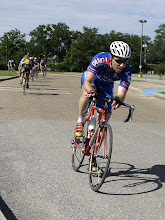Bike handling dynamics
In the past, I've written about bike handling dynamics and the things that you can do to improve this for yourself. Last night, a friend and I were talking about bike frame design. Specifically, we were talking about bike stability and the impact of fork rake and head tube angle. Much of this is new stuff to me as I continue to learn about frame design.
He pointed me to a web link that gives a great illustration of bike stability. When I say bike stability, I talking about a rolling bike without a human riding on top of it. The physics associated with a bike causes it to roll straight as long as the bike has momentum. It will maintain this straight line until the forward momentum is reduced and all the forces acting on the bike go away. Then, the bike falls down. You can see this as an experimenter rolls a bike across a parking lot..
Just to show how stable a bike is(without a rider), an experimenter rolls the bike forward a second time. This time, he runs along side and hits the saddle from the side. In fact, he hits the saddle rather forcefully. This causes the bike to immediately change direction but it quickly regains stability and continue once again in a straight line. Click Here
Here's the application. If the bike(without a human) rolls straight, what causes it to ride erratically once we get on it. "And the answer is.....the rider".
The rider brings a set of forces that are created during the process of pedaling the bike. These forces cause the bike to "change direction". However, to our benefit, the inherent stability of the bike keeps us from killing ourselves. Now, you can understand why a bike and rider are unable to ride a straight line. The rider is creating forces that move the bike all over the place. These forces require correction so that the rider is able reduce the danger to other riders in close proximity.
There is a remedy. Reducing these forces that cause the bike to move outside it's line can be learned. Your bike can roll straight with you pedaling it. Once, again, rollers are the key.


0 Comments:
Post a Comment
<< Home